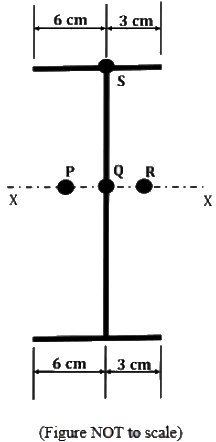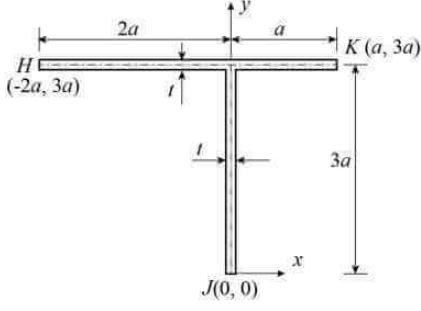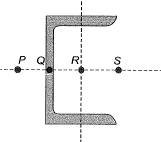Past Year Questions: Theory of Column & Shear Centre | Solid Mechanics - Mechanical Engineering PDF Download
Q1: For a thin-walled section shown in the figure, points P, Q and R are located on the major bending axis X−X of the section. Point Q is located on the web whereas point S is located at the intersection of the web and the top flange of the section. [2024, Set-II]
Qualitatively, the shear center of the section lies at
(a) S
(b) R
(c) Q
(d) P
Ans: (b)
Position of shear centre will be at R.
Q2: Consider the cross-section of a beam made up of thin uniform elements having thickness t(t<<a) shown in the figure. The (x, y) coordinates of the points along the center-line of the cross-section are given in the figure. [2022, Set-I] The coordinates of the shear center of this cross-section are:
The coordinates of the shear center of this cross-section are:
(a) x = 0, y = 3a
(b) x = 2a, y = 2a
(c) x = -a, y = 2a
(d) x = -2a, y = a
Ans: (a)
Shear centre of section consisting of two intersecting narrow rectangles always lies at the intersection of centrelines of two rectangles. Coordinate of shear centre (0, 3a).
Coordinate of shear centre (0, 3a).
Q3: A column of height h with a rectangular cross-section of size a x 2a has a buckling load of P. If the cross-section is changed to 0.5 a x 3a and its height changed to 1.5h, the buckling load of the redesigned column will be [2018 : 1 Mark, Set-I]
(a) P/12
(b) P/4
(c) P/2
(d) 3P/4
Ans: (a)


For new column,


Q4: Consider two axially loaded columns, namely, 1 and 2, made of a linear elastic material with Young’s modulus 2 x 105 MPa, square cross- section with side 10 mm, and length 1 m. For Column 1, one end is fixed and the other end is free. For Column 2, one end is fixed and the other end is pinned. Based on the Euler’s theory, the ratio (up to one decimal place) of the buckling load of Column 2 to the buckling load of Column 1 is _____. [2017 : 2 Marks, Set-I]
Ans:


∴ Required ratio =

Q5: In a system two connected rigid bars AC and BC are of identical length, L with pin supports at A and B. The bars are interconnected at C by a frictionless hinge. The rotation of the hinge is restrained by a rotational spring of stiffness, k. The system initially assumes a straight line configuration, ACB. Assuming both the bars as weightless, the rotation at supports, A and B, due to a transverse load, P applied at C is [2015 : 2 Marks, Set-II]
(a) PL/4k
(b) PL/2k
(c) P/4k
(d) Pk/4L
Ans: (a)
Deflection under load P= θL
Work done by force

 Strain energy stored in spring
Strain energy stored in spring

⇒ θ = PL/4k
Q6: If the following equation establishes equilibrium in slightly bent position, the mid-span deflection of a member shown in the figure is

 If a is amplitude constant for y, then [2014 : 2 Marks, Set-I]
If a is amplitude constant for y, then [2014 : 2 Marks, Set-I]



Ans. (C)

∴ Solution of above differential equation is,
y = a sin mx + b cos mx
at = x = 0, y = 0
⇒ b = 0
at x = L, y = 0
⇒ 0 = sin mL
⇒ mL = nπ
⇒

∴

Q7: The possible location of shear centre of the channel section, shown below is, [2014 : 1 Mark, Set-I]
 (a) P
(a) P(b) Q
(c) P
(d) S
Ans: (a)
 For no twisting
For no twistingV x e = H x h
⇒

Hence possible location of shear centre is P.
Q8: Two steel column P (length L and yield strength fy = 250 MPa) and Q (length 2L and yield strength fy = 500 MPa) have the same cross-section and end condition the ratio of buckling load of column P to that of column Q is [2013 : 1 Mark]
(a) 0.5
(b) 1.0
(c) 2.0
(d) 4.0
Ans: (d)
Buckling load,

∴

∴

Q9: The ratio of the theoretical critical buckling load for a column with fixed ends to that of another column with the same dimensions and material, but with pinned ends, is equal to [2012 : 1 Mark]
(a) 0.5
(b) 1.0
(c) 2.0
(d) 4.0
Ans: (d)
Eulars critical load,

|
33 videos|72 docs|29 tests
|
FAQs on Past Year Questions: Theory of Column & Shear Centre - Solid Mechanics - Mechanical Engineering
| 1. What is the theory of columns in structural engineering? |  |
| 2. How do you determine the shear centre of a structural section? |  |
| 3. Why is the shear centre important in design? |  |
| 4. What factors affect the load-carrying capacity of columns? |  |
| 5. What is the difference between short and slender columns? |  |





















